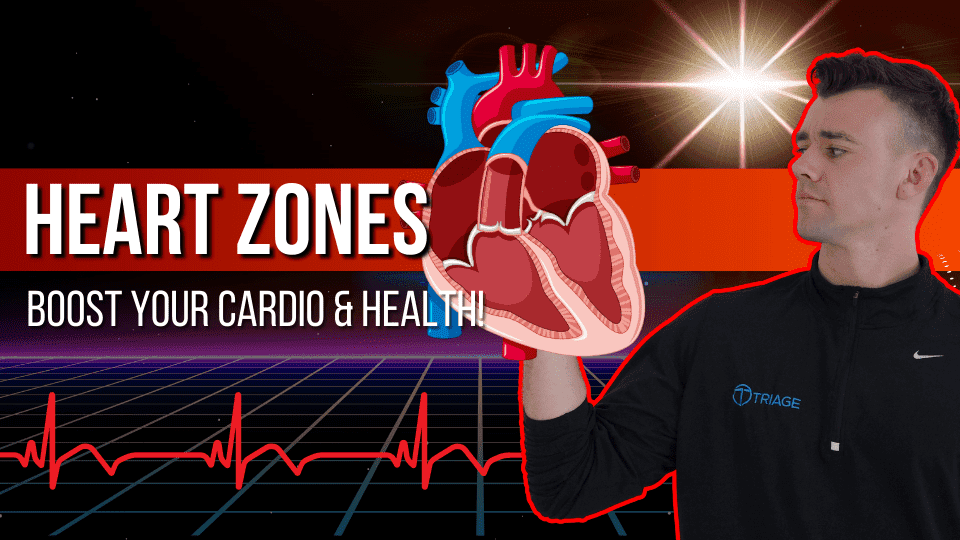You may have heard people discuss heart rate zones with respect to running training, endurance training, or even cardio training in the gym. And you may be unsure what these heart rate zones actually means, and what they can be used for. So that is what we aim to get into today. Now, one of the reason these heart rate zones are important is that they give us insight into the energy systems in the body that are contributing to energy metabolism during a given activity. This provides us with information about what fueled substrate we’re burning, for example, carbohydrates versus fat, and also the adaptations that we get from training. Finally, the really important part is that it gives us insight into the fatigue that’s generated by the activity. All of this information can be incredibly useful in designing training programs, and ensuring we are actually getting the adaptations we want from all our hard work training. We very often use heart rate zones in our coaching practices, and they can be incredibly useful for helping people train at the appropriate intensity for their goals. If you would like to calculate your heart rate zones, we do also have an online heart rate zones calculator that you can use.
Understanding Heart Rate Zones
Heart rate zones are typically listed from one to five. Zone one is often described as being from 50 to 60 percent of your maximum heart rate, zone 2 is from 60 to 70, zone 3 is 70 to 80, zone 4 is 80 to 90, and zone 5 then is 90 to 100 percent of your maximal heart rate. These, of course, are somewhat arbitrary, and some people will use different cutoffs, but it is a useful framework for programming endurance training.
Now, before we get into when you should train in different heart rate zones, it’s important to understand what the zones are actually signifying. Our maximal heart rate during exercise is often somewhere between 160 to 200 beats per minute. Some people will be a little bit higher, and some a little bit lower. There are genetic factors, there are health factors, and it changes with age, and so on. But for argument’s sake, if we take someone that has a maximal heart rate of 200 beats per minute and during an exercise session we observe that 200 beats per minute, that tells us that that person is working at maximal effort. They will not be able to sustain that activity for long because of how close they’re working to their max. On the contrary, if someone is walking around during the day at work, for example, then their heart rate might be between 30 and 50 percent of their maximum heart rate. This is far closer to the resting heart rate and this isn’t going to be very fatiguing at all, and therefore it can be sustained for a much longer period of time.
So, the lower your heart rate, the longer you can sustain that activity, and thus the lower intensity of the activity, the longer you can sustain it. This relates primarily to the energy systems that contribute to energy metabolism. When we exercise, we need to have a constant ATP supply, which is the energy currency of the body, in order to keep our muscles working. This goes whether we’re lifting weights, running, or even just walking around during the day. We can supply this ATP in a very fast manner or in a very slow manner. A very fast manner, for example, would be local ATP supply. We do have small amounts of ATP located within muscle cells, or it can be regenerated quite quickly using the creatine phosphate system. This creatine phosphate or phosphocreatine system is the reason that people will supplement with creatine or creatine monohydrate in order to enhance their power and strength outcomes, because this is a substrate for that phosphocreatine system, allowing for rapid regeneration of ATP for short, sharp, powerful activities.
On the other end of the spectrum, we have slow ATP production. This can come from either carbohydrates or fats. Fat metabolism is a bit slower and isn’t going to be able to keep up with high-intensity activities. Therefore, when we walk around during the day or we do very low-intensity cardio, we’re more likely to be using fat as a substrate during those activities. As we intensify, we use more and more carbohydrates. So, we can have aerobic or slow energy production using carbohydrates or fats. We can then have faster energy production via glycolysis using carbohydrates, and then we can have the fastest energy production using ATP locally within the muscle or regenerating it using creatine phosphate.
If we’re exercising in, let’s say, Zone one to Zone two, this is primarily an aerobic activity. We’re primarily using slower energy systems, and as we do this, we’re generating fewer byproducts of fatigue. Byproducts of fatigue include acidosis, for example. You see, when we work at very high rates and we run glycolysis really quickly, we generate a lot of hydrogen ions or acidosis within the muscle (that burning sensation you feel in your muscles). This can compromise muscle function, which is why we get buffering of this acidosis using buffering molecules such as lactate. This is the reason we see lactate rise during exercise as a buffer for the acidosis generated by fast energy production via glycolysis.
So, the real problem is that as we move towards the higher energy systems, we have to generate more and more ATP anaerobically using these fast systems, and we get a lot of fatigue along with that. So, when we’re in Zone one to Zone two, we’re not quite tapping into those stores. We’re getting more ATP at a slower rate, and this creates a condition where we can sustain this activity for a much longer period of time. For example, you could do one to two hours of Zone two cardio without feeling too beat up (unless you have very low energy availability, as may be the case when you are quite lean, your diet isn’t well set up or you are just in a steep calorie deficit). So, you’re getting a potent aerobic training stimulus without lots of fatigue associated with it. Of course, you will begin to become fatigued, particularly as your volume increases. There are limits to continuing to supply these energy substrates. You can’t sustain activity indefinitely, even if we’re in these lower heart rate zones. For general health purposes, when we program cardio for someone that’s trying to improve their health, improve their energy levels, and improve their well-being, we’ll spend a lot of our time in and around that Zone 2 level.
The big benefit of working in and around Zone two is that you can get the benefits of cardio, such as increasing your VO2 max, and promoting health, and you do so without totally beating yourself up in the gym. There is still utility, even from a health perspective, to getting into heart rate zones three, four, and five, and this can be especially time-efficient. These are always the trade-offs that you’re dealing with. We can do Zone two, and get less fatigue, but it’s going to take a lot of time and it can often be boring for people. Alternatively, we can do intervals where we’re dipping into heart rate zonez four and five, where the workouts are shorter but also far more difficult in the short term. From a general health perspective, we recommend a balance of the two, and most of my coaching clients here at Triage would do both the lower intensity and higher intensity cardio.
Heart Rate Zones In Practice
So, as a practical application to this heart rate zones knowlege, let’s say I have a maximal heart rate of 200 beats per minute and I want to do 45 minutes of cardio at around Zone two. That will be 60 to 70 percent of my maximum heart rate, which would be 120 to 140 beats per minute. As I go into Zone three at 140 to 160, it’s not going to be that fatiguing, but we’re going to be just nudging towards that point where we have more anaerobic energy metabolism, a bit more fatigue, and a bit more of a physical challenge moment to moment during the workout. That doesn’t mean it’s a bad thing; you just have to understand this within the context of what you’re trying to achieve with your programming.
Then, what we would do with our intervals, for example, let’s say we’re getting on the assault bike and we’re doing 30 seconds on, 90 seconds off. If I’m doing 30 seconds on, I want to see myself getting towards that Zone five, at least towards the second half of that interval. That would mean 180 to 200 beats per minute. I wouldn’t expect to see 200 beats per minute consistently for 30 seconds; that’s going to really take it out of me. What I’d be more inclined to program would be seeing maybe 170 to 180 on the first interval, 180 to 190 on the second interval, and so on. And then maybe dipping into that real high Zone 5, 190 to 200, as the intervals progress. This is how we program cardio in accordance with heart rate zones. You don’t need to get too obsessed by programming with heart rate zones in mind, but knowing these basic practical points can help you to get more from your cardio training, benefiting your health, performance, and body composition.
If you are interested in energy systems and how it applies to nutrition practices, we do actually cover this in our nutrition coaching course. If you need help with your own training, then we do also offer comprehensive online coaching. If you enjoyed this content, we do produce a lot of content on the website and for our YouTube channel.

Gary McGowan
Hey, I am Dr Gary McGowan, co-founder of Triage, qualified Doctor, Physiotherapist, and Coach.
Having graduated with first class honours in Physiotherapy (BSc) and Medicine (MB BCh BAO), I aim to blend medical science with a decade of coaching experience to help you maximise your performance, transform your body, and optimise your health.
I enjoy grappling, hiking, lifting, and other modes of physical training. When I’m not training, I like to read broadly, particularly philosophy, religion, and history. I love the natural world, particularly the mountains & lakes of my hometown Killarney, County Kerry.


